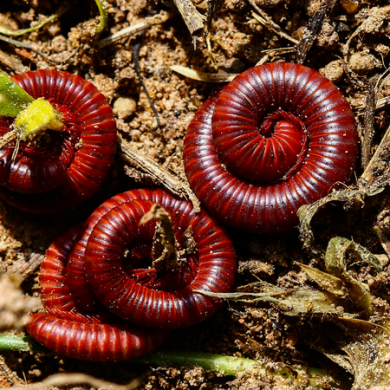Milipedes
Millipedes are long, cylindrical arthropods with one pair of legs per segment. Millipedes are sometimes called the “thousand leggers” because this is roughly how many body segments they have. Like centipedes, millipede bodies end in a pair of legs on each segment, although centipede bodies only have a single pair of legs per segment. Millipedes are usually found in damp, moist areas like under rocks or logs.
Some millipede species produce cyanide as a chemical defense against predators while others emit foul-smelling liquids from glands called ozopores, which is similar to the behavior of stink bugs and leaf beetles.
Millipedes
Behavior of Millipedes
Millipedes are long, many-legged insects that curl up or roll into a ball when touched. They excrete a smelly fluid to dissuade predators and also produce an audible hissing sound to scare off potential attackers. Millipedes do not bite people or pets, but they can be dangerous if the large front legs break off in the skin, resulting in a painful injection of the organism’s toxic fluid.
Millipedes are usually found indoors as they seek dark, damp spaces to hide during daylight hours and become active at night. Because millipedes get moisture from the air around them, it is best to keep any doors or windows closed at all times including while you’re asleep. Millipedes may be accidentally brought into your home in bags of vegetables or other items purchased at the grocery store.
Millipede Removal Tips
- Check all produce, especially potatoes, carefully for millipedes and other insects before bringing it inside
- Keep floor areas such as basements and laundry rooms dry (use dehumidifiers as necessary)
- If millipedes are found in large numbers on the floor or walls, consult a pest control professional for advice and assistance with removal.
Bites and Treatments
Millipedes usually do not bite humans. Millipede bites are often mistaken for bee stings since the insect’s legs tear off easily when they feel threatened and inject venom into their predators. It is important to note that millipede pain is often more intense than a bee sting, as they have larger body masses (and accompanying muscle) and stronger venom.
The legs of millipedes can break off in the skin, resulting in a very painful injection of the toxic fluid. If a millipede leg becomes lodged under your skin, do not attempt to remove it yourself as this may cause more damage. Seek medical attention immediately if you or a loved one have been bitten by a millipede.
Prevention of Millipedes
Keeping moisture levels low is key to controlling millipede populations, as these insects are sensitive to dry conditions and will suffer or die if exposed to more than 5 percent moisture content in the air. Periodic dehumidification and ventilating basements help keep humidity down.
Keeping potential food sources, such as potted plants, away from windowsills where millipedes may be able to enter is another good way to prevent them from coming into your home.








